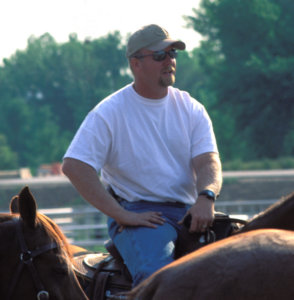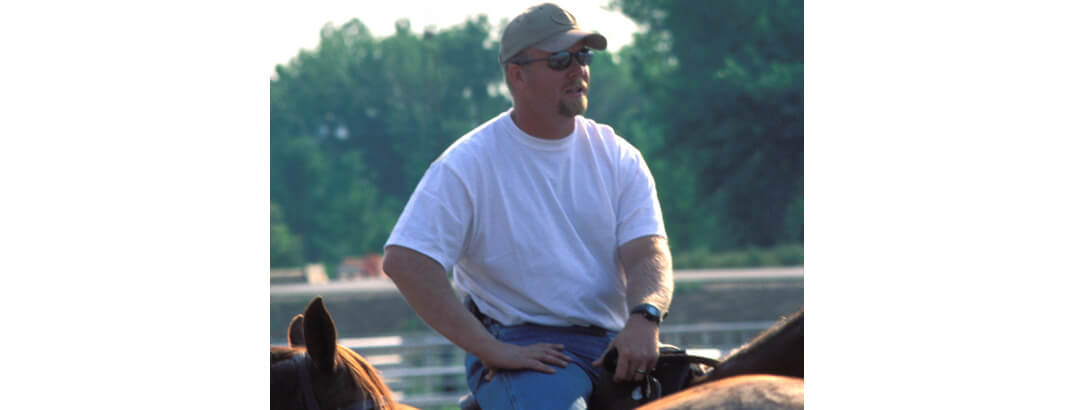Successful Horsemen Are Always “In Training”
by Raye Lochert

Everyone who has worked with me knows that I trained with John Lyons. Some know that I worked even more with Josh Lyons. A few know that I’ve worked with Richard Shrake and even fewer know that I have an extensive video/DVD collection of almost all the top clinicians and some trainers nobody has heard of. I also use my DVR to record nearly every horse show that pops up on TV, read most of the articles in the 8 different equine magazines I receive each month, travel long and short distances to watch clinics and demonstrations, and read up on new training techniques found on the web. And then there’s the horse and its owner and their support team (vets, farriers, etc.). You wouldn’t believe how much I learn from them! Basically, I am constantly in training.
My training is going pretty well so why do I do this? Because I want to see how everybody else is doing it. What new valuable tool have they discovered that could really help me in my constant search to find the easiest and safest way to work with my horse? Is it easier for me? Is it easier for the horse? Or, better yet, both? The real reason is this: Because I love the sweet satisfaction of seeing the horse or rider I’m working with GET IT!
When I watch other trainers I try to look at the technique from the horse’s point of view. Does it make sense to the horse? Are the conditions safe to do the exercise? Is it fair? Does it involve pain? The horse tells me if the technique will work and will be a good addition to my training routine. Does the technique allow me to shorten my training time without sacrificing the horse? Are there aids used such as tie downs and martingales? If so, I won’t use it. Not that they don’t achieve results but rather because I see it as a band aid and that’s not how I like to resolve problems. I like getting the most positive results with the least amount of aids.
Watching other people with horses gives me more tools in my bag. I love good tools and the more, the better (Just look at my workshop)! Having different tools for the same situation allows me to adjust my training to the horse and to the owner. One method may work really well for one horse and rider while another will work better for a different horse and rider.
In my profession the ability to explain things to a large range of people is crucial. Watching other trainers allows me to hear different ways of explaining the same thing. This in turn makes me a better communicator. Not only to people, but also to the horses. When watching other people work with horses, whether they are clinicians, trainers or owners, it’s really easy to find what you don’t like. Some make it a lot easier than others! But watching closely you can almost always find something you do like. This is the hard part. Keep an open mind when watching other people work with a horse. Realize that if they are in the equine business there’s a pretty good chance that they have something to offer from their experiences. It may or may not be to your liking, but sometimes our most valuable lessons in life are learning what not to do. If you close your mind to other theories or techniques you are only hurting the chances of growth with you and your horse.
There are always lessons to be learned!
Published October 2011 Issue
Practical Horsemanship – that’s Raye. In an industry that’s exploding with information and trainers, Raye takes the confusion out of horse training. By taking a problem and breaking it down into smaller, doable steps, his solutions create successes for all horse people. No matter the discipline, the age of the horse or the level of experience or expertise of the rider, success is the end result.
There are many fantastic trainers in this industry. Unfortunately, a lot of what is being taught can’t safely be used by the average horse person. Raye wants to relay information in a way that makes sense and feels safe to everyone. If the horse handler finds it confusing or complicated, the horse doesn’t stand a chance.
In the vast sea of horsemanship clinicians, Raye is considered one of the most accessible teachers with an approachable style that truly sets him apart. His intense desire to help people achieve clear and consistent communication with their horses creates a much higher level of learning with his clients. No problem is too small and no question is silly.
In addition to clinics and lessons at Critter Creek Ranch in Santa Rosa, California, Raye travels all over the Western United States (including Hawaii and Alaska) conducting clinics, private lessons and demonstrations. His teaching is also available on DVDs and in special television programming. For more information on Raye Lochert and his schedule, visit Raye Lochert Horsemanship on Facebook.






